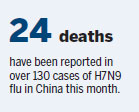2 bird flu clusters raising concerns
Human-to-human transmission cannot be ruled out, source says
China reported two clusters of human cases of H7N9 bird flu last month, according to a source with the National Health and Family Planning Commission who warned that "we cannot rule out human-to-human transmission".
The number of infections spiked in December to 106, up from just six in the previous month, according to data from the Chinese Center for Disease Control and Prevention.
However, two clusters - two or more cases in the same place - in eastern China have raised concerns of human-to-human transmission.
One involved a 66-year-old man and his 39-year-old daughter in Suzhou, Jiangsu province, who both tested positive for H7N9, said the health commission source, who spoke on condition of anonymity.

He said the father, who had had contact with live poultry at a market, was diagnosed first, and the daughter contracted the virus while tending to her sick father. She had had no exposure to live poultry.
The other cluster, in Hefei, Anhui province, was not family-related but involved two men in their 60s who were admitted to the same hospital ward. One had confirmed contact with live poultry, and the second was suspected of contracting the virus while in the hospital ward, the source said.
For any clusters, "we conduct a thorough epidemiology investigation, and all those in close contact with the infected are tested for the virus", he said, adding that the cases last month did not provide a reason to panic. "There is definitely no sustained human-to-human transmission," he said, adding that the virus is not known to have mutated.
This month, more than 130 cases of H7N9 flu have been reported in China, including 24 deaths.
The World Health Organization urged all countries on Tuesday to monitor bird flu outbreaks in birds and to report cases in humans that could signal the start of a pandemic.
Tallies by the UN health body showed that around 40 countries and regions worldwide have reported avian influenza outbreaks involving various strains in poultry or wild birds.
The Chinese Center for Disease Control and Prevention has been closely monitoring the H7N9 virus since the first reported case in China in 2013, said Ni Daxin, deputy director of the center's emergency response department.
However, a tricky thing about H7N9 is that it doesn't cause symptoms in the birds infected, said Shu Yuelong, head of the Chinese National Influenza Center.
"That makes it difficult to detect the outbreak in birds and to curb secondary transmission from bird to man," he said.
In China, human cases of H7N9 have been reported mostly in 11 southern provinces including Jiangsu, Anhui and Guangdong.
Shu said that's highly related to the eating habits of people living in those areas. "People there prefer live poultry to the frozen kind."
He recommended that consumers shift to frozen poultry and stay away from live poultry markets.
shanjuan@chinadaily.com.cn
























